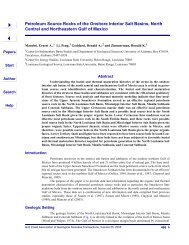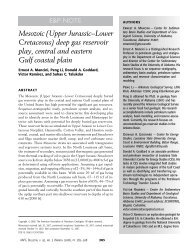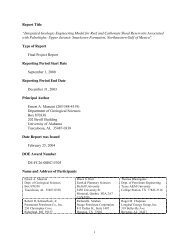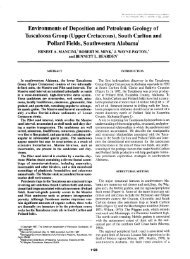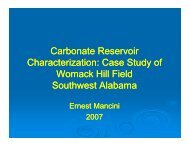Part 4 - Berg - Hughes Center
Part 4 - Berg - Hughes Center
Part 4 - Berg - Hughes Center
Create successful ePaper yourself
Turn your PDF publications into a flip-book with our unique Google optimized e-Paper software.
1990). The Smackover Formation, which was deposited on a ramp surface during the<br />
major Jurassic marine transgression in the Gulf, includes intertidal to subtidal laminated<br />
and microbial lime mudstone, subtidal peloidal wackestone and packstone, subtidal<br />
microbial boundstone, and subtidal to intertidal peloidal, ooid, oncoidal packstone and<br />
grainstone interbedded with fenestral lime mudstone (Mancini and Benson, 1980;<br />
Benson, 1988; Dobson, 1990). This transgression has been attributed to emplacement of<br />
oceanic crust in the Gulf and the resulting thermal subsidence due to crustal cooling<br />
(Nunn, 1984; Winker and Buffler, 1988). The Haynesville Formation consists of<br />
subaqueous to subaerial anhydrite, shelf to shoreline limestone, shale, and sandstone and<br />
eolian, fluvial, and alluvial sandstone (Tolson et al., 1983, Mann, 1988; Mancini et al.,<br />
1997). The Cotton Valley Group includes fluvial-deltaic and delta destructive sandstone<br />
and shale (Moore, 1983; Tolson, et al., 1983; Dobson, 1990). Deposition of the Early<br />
Cretaceous Knowles Limestone has been interpreted as the precursor to the development<br />
of the Lower Cretaceous carbonate shelf margin (Dobson, 1990).<br />
The Early Cretaceous in the northern Gulf of Mexico consists of fluvial-deltaic to<br />
coastal siliciclastic sedimentation updip and the development of a broad carbonate shelf<br />
with a low-relief margin downdip at the boundary between thick transitional crust and<br />
thin transitional crust (Eaves, 1976; Winker and Buffler, 1988; McFarlan and Menes,<br />
1991; Sawyer et al., 1991). The development of a carbonate shelf margin during the Early<br />
Cretaceous, which does not conform to the basement structure, is the result of a<br />
combination of a change in the slope of the basement that is marked by a crustal hinge<br />
zone and Jurassic sediment depositional patterns (Dobson, 1990; Sawyer et al., 1991).<br />
The hinge zone has formed as a result of differential subsidence across the crustal<br />
435




